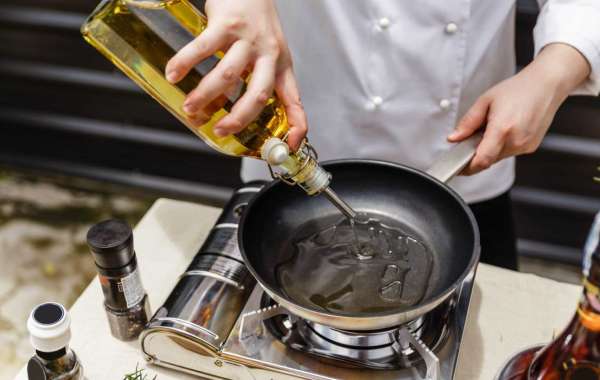Best Oil to Cook
At one of the first restaurants I worked at, we used three kinds of oil. The first was a simple vegetable oil used to fill the deep fryer. The second was a “finishing oil,” a fancy-looking extra-virgin olive oil. It was used sparingly, mostly by the chef, who drizzled a little bit on the plates right before they were brought out to the dining room. The third was “blended oil” that came in a yellow jug. As the name suggested, it was a cheap mix of canola oil and (what seemed to be) a small amount of extra-virgin olive oil. It probably didn’t taste that great when I think about it now, but it was our go-to. We used it for pan-frying, vinaigrettes, aioli, and just about anything else you could think of.
After I quit that job, I never saw that strangely blended oil again, but I started to think about it again a few years ago when, after doing some research, I decided to only stock high-quality extra-virgin olive oil. Unfortunately, I had trouble right away with two things. The first problem was that my favourite brands were expensive—a small bottle could easily add $20 to my grocery bill—and they went out of stock way too quickly.

Strangely, the second problem was how good these oils tasted. I started to notice that the peppery and grassy flavours I liked in these extra-virgin olive oils were too strong for simple vinaigrettes and too strong for delicate sautés. I had too much flavour and not enough flavour at the same time.
At that same moment, the yellow jug with the mixed oil began to make more sense. Therefore, I started tinkering around with homemade hybrid oils at home. When I got my hands on a wonderful tin of extra-virgin olive oil, I first measured out a cup of the oil. Next, I put it in a squeeze bottle with around two cups of decent neutral oil, such as grapeseed or sunflower. I then mixed the two oils together. This way, I could still have some pure stuff in reserve for times when I wanted Big Olive Oil Energy, such as finishing a grilled pork steak or drizzling it over bowls of pureed soup. However, I would also have a great-tasting workhorse oil that I could reach for without worrying that it would take over a dish (or bankrupt me).
The precise proportions of my house blends change depending on the olive oil I’m working with—I tend to dilute particularly potent oils more than milder ones—and the kinds of uses I have in mind for my blended oil. For example, when working with particularly potent olive oil, I’ll dilute it more than I would with a milder oil. Suppose I believe I’m going to use the oil uncooked, as in a vinaigrette or salsa verde, or anyplace else where I want the robust flavour of olive oil without having it overpower the dish. In that case, I opt for a ratio of two parts neutral oil to one part olive oil. Finally, suppose I want the olive oil to have even less of a presence in the dish, such as when I’m roasting or sautéing vegetables. In that case, I’ll use a ratio of 3:1 or 4:1 olive oil to vegetable oil.

Having said that, any ratio will save you money and reduce the number of olives you consume to an unhealthy level. Therefore, use it cautiously when you find a combination that works well for you. You may use it to steal fish. Put vegetables in it to roast them. You may create cereal with it, caramelise onions with it, or even cook eggs with it. It’s possible that you, as I do, will discover that the dilution lets you clearly appreciate the olive oil’s complexity. This is similar to how adding a splash of water to a fiery whiskey opens up the flavour. If not, then you won’t! In either case, purchasing the bottle of mixed oil resulted in cost savings.
Most seed-based cooking oils in India are high in monounsaturated or polyunsaturated fatty acids, so you can only benefit from one. Blended oils, sometimes called Multi-source edible oils, mix two oils in the proper proportions to provide the benefits of each. You won’t notice much of a difference in flavour. Still, it’s better if you’re seeking the healthiest cooking oil in India.

Rich in MUFAs and PUFAs
Blended oils mix two oils into one healthy cooking oil, providing MUFAs and PUFAs. Making blended oils isn’t as easy as combining oils in any quantity. However, the combination contains a precisely determined amount of both oils. As a result, long-term usage of cooking oils with the proper fatty acid composition may help Indians avoid heart disease.

Blends’ smoke points might be higher than single-source oils.’
Many single-source oils have a low smoke points. Therefore, they can’t be utilised for frying. Lower smoke points imply oils heat up and smoke quicker, requiring removal from heat. Blended oils have a greater smoke point than their constituent oils, making them ideal for cooking.
Cooking oil versatility
Blended oils have a high smoke point, making them versatile. They have a neutral flavour, so you don’t have to worry about affecting the taste of your meals. In addition, their flavour is scarcely apparent, allowing other components to show through.
They reduce oil use
Healthy cooking oils should be used in moderation. Saffola Gold blended oil has LOSORBTM technology, which reduces absorption when frying.







